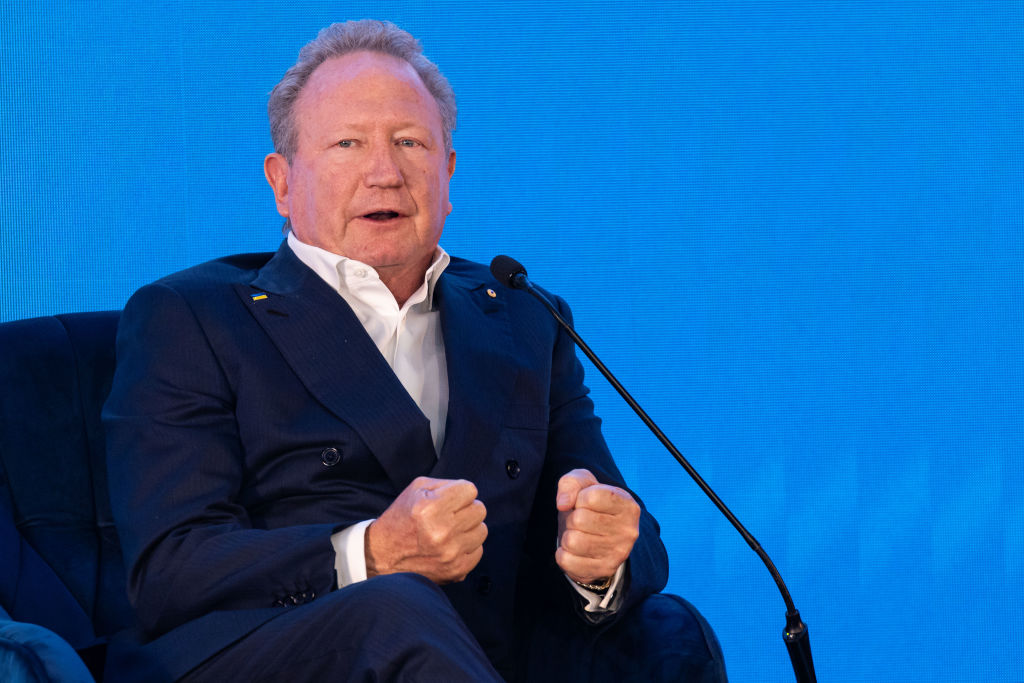Andrew Forrest’s FMG copped a first strike against its remuneration report for executive and director payments defended by the mining billionaire
Fortescue’s iron ore boss says its new blend of “green” high grade and low grade iron will help FMG ride out cycles in steel market
The Fortescue (ASX:FMG) AGM in Perth yesterday was as uneventful as an ASX 20 company meeting could be that could also be fairly described as eventful.
Andrew Forrest’s near $80 billion iron ore miner is near the apex of its historic performance, trading at a higher share price than it did at any point aside from the short-lived iron ore boom of 2021, briefly after prices hit US$237/t.
A recent charge in prices has again provided FMG the steam for its magnetic run — hitting a year’s high of US$133/t yesterday. That has seen it hit those heights despite continued angst from analysts over the sustainability of its shift into the capital churning field of green energy.
Forrest would, no doubt, say the recent strength in FMG is a testament to the support of shareholders — more than ever before he told the room at Crown Perth’s Astral Ballroom — for its transition from pure play iron ore miner to purveyor of green everything.
Amid it all there are notes of discontent. A first strike against FMG’s remuneration report in protest against executive payments delivered to former CEO and now executive director Elizabeth Gaines and former CFO Ian Wells was the big call from shareholders not named Twiggy.
A massive 52.44% of votes were tabled against the company’s corporate pay proposal. That vote has no immediate effect, but does mean FMG will need to improve relations with proxy advisors and institutions unhappy with the one-off payments and executive churn which included a run of a little over six months for departed metals CEO Fiona Hick.
– Chris Ellison
Speaking after the meeting to media Forrest defended the executive payments — and payments to deputy chairman Mark Barnaba — that ran afoul of the proxy advisors’ “rule book”.
“It was to a couple of directors, which I needed to drag out of their nice cushy, non-executive life and make executive,” Forrest said.
“For that kind of money it’s fractional to what I’d have to pay them if they weren’t already very well known to Fortescue, and to our mission but it appears as a one-off payment. Such is life, it did cross their rule book.
“We’ve spoken to them about that, said ‘look, we didn’t have a choice about this’. We really needed this talent. We need them even more now. And as you can see from the shareholders everything’s sweet.”
The reaction in the room was indeed mild, to the point that no one even asked a question about the protested rem report. Motions to reappoint a string of directors including Forrest and 14-year vet Barnaba — who will relinquish a role as ‘lead independent director’ over the next 6-12 months — also went off without a hitch.
What’s keeping the shareholders happy?
Iron ore prices are certainly helping with that.
FMG sold 192Mt of iron ore last year at cost of US$17.54/wmt. At current prices the margins are extraordinary, even when you take into account discounts for its lower grade iron ore. It delivered an $8.2b underlying net profit after tax and paid $5.4b in dividends, around 37% of that to Forrest and his recently separated wife Nicola.
That also provides the juice to get Forrest’s green energy business up and running, with the company announcing three FIDs yesterday committing to US$750m in funding for two green hydrogen plants in the US and Australia with a combined capacity of 19,400t and a 1500tpa green iron pilot plant at the Christmas Creek mine in the Pilbara.
How long will those taps continue?
China is a curious beast. Many of its traditional indicators — like property investment and steel mill profitability — have been awful in 2023. Yet prices have surged with port stocks at low levels and supply from the majors not quite as strong as expected.
That’s good for Fortescue in the short term since the bulk of its iron ore is lower grade — Chinese steelmakers are in need of material but don’t want to pay as much for it, meaning discounts for lower grades contract.
Fortescue Metals boss Dino Otranto told media yesterday the introduction of higher grade material from the green iron plant, Iron Bridge magnetite mine and Belinga in Gabon — the latter two expected to become sources of high grade feed for lower emissions steel processes than conventional blast furnaces — meant FMG’s iron ore product suite would be ‘counter-cyclical’.
“Just returning from China, my comments now is it will have a little bit more wind in its sails,” he said.
“We’ve got a product suite that’s quite unique — it’s countercyclical.
“So at the moment, with low steel margins our sector is doing very well, we’re represented very lowly in stocks in China.
“But with Iron Bridge coming online now, we’re seeing a huge demand for that product with a higher grade going into the green steel sector.
“And what was quite instrumental and why we made the announcement on green iron today is it’s clear that the steel mills now in China have have had a direction to go green for a segment of their portfolio by 2030.
“Coupled with that we’re still seeing demand of about a billion tonnes of crude steel coming out of China. So our products are well positioned, certainly for the next coming years.”
FMG expects to deliver its first shipment next week from Belinga, though plans to ship as much as 2Mt in its first year have been dialled back to around 100-200,000t, with studies and drilling for a larger scale operation still ongoing.
The US$4b Iron Bridge has seen its guidance for 2023-24 cut from 7Mt to 5Mt, but FMG still says it can hit nameplate of 22Mtpa within two years — expected to be around August 2025.
MinRes confident iron ore expansion will pay off
FMG is not the only large Aussie miner confident in the near term outlook for iron ore.
Mineral Resources (ASX:MIN) expects to open the 35Mtpa Onslow Iron project in mid-2024, in which it will have a stake of a little over 60%.
Boss Chris Ellison said at last week’s AGM the miner more known currently for its lithium ambitions saw strength in the Chinese iron ore market. Among its major partners is Baowu, China’s largest steel producer.
He shook off concerns around the health of China’s building industry, which he said had been brewing for “5, 6, 7 years” and “never seem to come to reality”.
“I’ve been to those towns that no one lives in. They’ve been around a long, long time,” he said.
“I would be a lot more concerned about the US balance sheet than I would around China’s building industry.
“The view of the guys from Baowu was that iron ore will probably hover around about where it is, it might move 10 or 15 or 20 bucks a tonne maximum over the next three to four years.
“So I feel very confident with iron ore and look, we can put it on on a ship for about $26 US a tonne, that gives us a lot of headroom.”
While Onslow will be exporting a product of around 58.5% Fe, Ellison said the emissions savings from higher grade iron ores in the blast furnace process were only “slightly less”.
“We’re going to be exporting about 58 and a half per cent. A big chunk of the iron ore coming out of the Pilbara now is less than 60%. So I think it’s a pretty solid project.”
MinRes has set a target of ramping up its iron ore exports from under 20Mt to 80-85Mt, replacing its marginal Utah Point and Koolyanobbing operations with Onslow — where Ellison thinks it could eventually ramp up to 50Mtpa — and deposits to be developed and exported through shared infrastructure with Hancock Prospecting at Port Hedland’s South West Creek berth.
ASX iron ore stocks
Scroll or swipe to reveal table. Click headings to sort.
Did Whitehaven get a raw deal on BHP mines?
While iron ore received a bump from potential Chinese stimulus measures yesterday and news India’s steel consumption had risen 14% YoY, the premium hard coking coal price didn’t play ball, down 3.1% to US$313/t.
That remains super-strong by historic levels and a massive premium to the US$123/t price being traded for 6000kcal Newcastle high CV thermal coal.
No wonder Whitehaven (ASX:WHC) saw fit to toss a potential $6.4 billion BHP’s (ASX:BHP) way for its Daunia and Blackwater met coal mines in Queensland.
There are a few naysayers though to the deal, due to close in the middle of next year, which will mean 70% of WHC’s revenues will in future come from steelmaking coal.
Bell Rock Capital succeeded in getting shareholders to deliver a strike to its rem report last month at Whitehaven’s AGM. Though they whittle down their stake in the aftermath, with their campaign not successful in preventing WHC from doing the deal, which does not require the support of shareholders.
Meanwhile, a note from the unrelated Bell Potter has cropped up, knocking down Whitehaven’s price target from $7 to $6.50 on balance sheet risks around the transaction.
That runs counter to much of the response from the financial community, and the immediate reaction of shareholders, who pushed Whitehaven’s price significantly higher when the deal was announced.
Whitehaven is rated as undervalued by Morningstar, with consensus rating it a ‘moderate buy’.
Citi lifted its price target on Whitehaven from $7.84 to $8.45 on the back of the transaction in late October, with earnings per share expected to increase 93% in FY25 to $1.44 on the back of the new assets.
ASX coal stocks
Scroll or swipe to reveal table. Click headings to sort.
The post Bulk Buys: Fortescue cops a strike while the iron ore’s hot appeared first on Stockhead.























+ There are no comments
Add yours